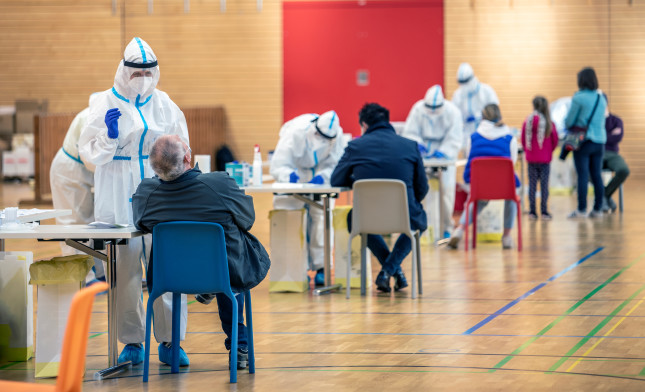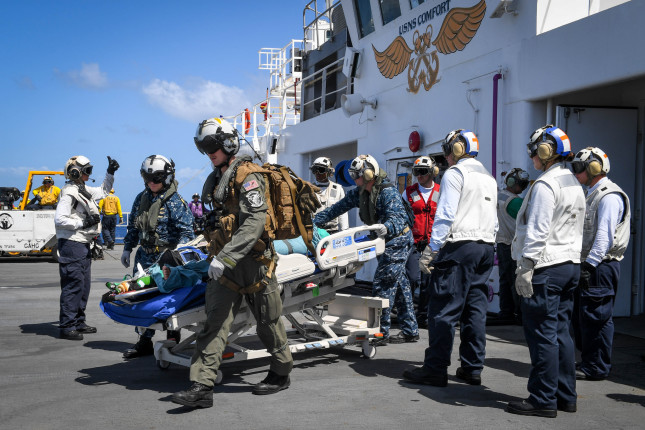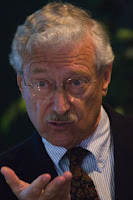-
Creating a New Normal with a New Global Public Health System
›
“Ask a big enough question, and you need more than one discipline to answer it,” said modern dance legend Liz Lerman.
As the COVID-19 pandemic spread across the globe, the World Health Organization (WHO) warned that there would be no going back to normal. They knew a failure to make timely and accurate public health decisions for a pandemic would prove to be the “difference between life and death.” How correct they were.
-
Disasters Have Changed. So Must Our Response.
› As disasters have changed over the years, so must the personnel who manage these crises.
As disasters have changed over the years, so must the personnel who manage these crises.In 1932, sociologist Lowell Carr first described a predictable pattern of how disasters impact society. Refined over the decades by many researchers, the “disaster cycle” includes four phases: prevention, preparedness, response, recovery and rehabilitation.
This disaster cycle helped define the way societies respond to each disaster. Today, highly trained emergency personnel using many research, management, and epidemiological skills have helped improve survival and health outcomes after disasters. “Disaster medicine” now defines a sub-specialty for highly skilled professional health specialists. However, their many activities and skill sets primarily focus on only the response phase of the initial disaster cycle.
-
Hurricane Maria’s Death Toll: Public Health Researchers Voice Frustration
›
Once again, we find ourselves witnessing another calamitous hurricane event in the United States, just weeks after a George Washington University report estimated that nearly 3,000 more people died in the 6 months following last year’s Hurricane Maria than would have without the hurricane. We have been here before, too many times. With each and every major disaster, the scientists who study public health in crises ask ourselves, is what we have learned and shared being taken seriously—or is it just being ignored? The response to Hurricane Maria, which devastated Puerto Rico last year, is just one more example where we have to ask if our work is valued by those who have the political power to improve public health. The staggering number of excess deaths—most of whom died after the storm—point to a deadly lack of prevention and preparedness, particularly in the public health system.
-
Wartime Public Health Crises Cause More Deaths Than Weapons, So Why Don’t We Pay More Attention?
›
In 2004 I was honored to be interviewed for The Lancet medical journal’s “Lifeline” series. I had just come away from a disastrous short tenure as the interim minister of health in Iraq following the 2003 war. I had support from former Secretary of State Colin Powell to rapidly mitigate and recover the war-related destruction of essential public health infrastructure and protections required as occupiers under Articles 55 and 56 of the Geneva Conventions that follow every war.
-
Civil-Military Interface Still Lacks Operational Clarity
›The Quadrennial Diplomacy and Development Review (QDDR) is an important first step in redefining civilian roles and capacities in crises, conflict, and instability. After the expensive failures of both the military and USAID in Vietnam during the 1960s and 70s, Congress set new guidelines governing military interventions and assistance to foreign governments. Foreign assistance staff was cut from 15,000 to 2,000 people. When modern-day conflicts arose and USAID found itself understaffed and under-funded, the military was called upon to fill a gap and became overnight, in essence, our primary development agency.
-
The Contradictions That Define China
›As a China follower who has visited the country numerous times over the past 40 years, I have an enduring love affair with the “old” China, which prided itself on balancing the harmony of nature with its decision-making. It is tragically ironic that despite this impressive historical and cultural backdrop, current choices have pushed the country’s harmony with nature beyond the tipping point.
The atmosphere in Chengdu, the capital of Sichuan Province in central China, tells a cautionary tale of China’s current emphasis on economic growth at the expense of its citizens’ health. With lower annual sunshine totals than London, Chengdu’s perpetually grey, cloudy horizon graphically illustrates the massive industrial waste and coal-fired pollution that plague this booming city.
In April, global health experts convened in Chengdu at the 5th International Academic Conference on Environmental and Occupational Medicine, which was co-sponsored by the U.S. Centers for Disease Control and Prevention and Chinese CDC offices, to report on the impact of climate change on public health.
Because of its geography, the mountain-encircled basin in which Chengdu sits is the natural point of release for daily deposits of air pollutants and dust blown in from India and other countries to the west. A rapid series of satellite views presented by John Petterson, director of the Sequoia Foundation, brought gasps from conference attendees, as these accumulated industrial wastes were shown concentrating against the massive southern Tibetan mountain range, then turning grey and black as they moved east, before being deposited on Sichuan’s vulnerable (and already heavily polluted) basin.
Environmental risk factors, especially air and water pollution, are a major–and worsening–source of death and illness in China. Air quality in China’s cities is among the worst in the world, and industrial water pollution is a widespread health hazard.
And although air pollution is clearly a complex global problem, individual nation-states continue to approach this dilemma as though it lies between its borders alone.
Luckily, this conference was prefaced by a number of timely scientific articles on China in the Lancet. The predominantly Chinese authors clearly take the critical risks that we expect from the Lancet, which is a defender of accountability and transparency in global health. This issue brings shame to other publications who still consider their “place” to be protecting the conventional politico-economic emphasis on decision-making inherent to most industrialized countries.
At the conference, public health and climate experts openly voiced their frustration at the blatant privileging of economic priorities over the health of unknowing populations. China–the fastest growing economy in world history, with unprecedented growth driven by external “demand” and precipitous acceleration of domestic consumption–has become the poster-child for global ignorance. However, the West is an equal and essential partner, having moved their manufacturing to China for cheap labor, lax environmental regulations, and higher profits.
Dr. Mark Keim, senior advisor for the CDC’s National Center for Environmental Health, presented irrefutable evidence that root structure erosion from advancing saltwater has led to starvation in Polynesia, the first recorded evidence-based outcome measure of climate change’s public health effects.
At Mark’s request, I presented evidence on the worsening health impacts of rapid urbanization, specifically within urban enclaves that expand due to dense population growth before protective public health infrastructures and systems are in place (forthcoming in Prehospital and Disaster Medicine). Currently, the megacities in Asia and Africa–where sanitation is ignored and infectious disease is prevalent–now have the highest infant and under-age five mortality rates in the world.
Today, we face the largest gap in health indices between the haves and have-nots since the alarming days before the Alma-Ata Declaration. This new health data was an uncomfortable surprise to many conference attendees, most of whom were experts in the physical and environmental sciences.
We have become too “vertical” in our research over the past 50 years, and thus we fail to recognize that solutions to problems facing the global community must be trans-disciplinary and multi-sectoral, and serve multiple ministries and decision-makers.
If not undone by human decisions, global climate change and climate-warming greenhouse gases will rapidly intensify. This effort requires the best collaboration between science and the humanities, as well as the harmonious lessons of the “old” China.
Frederick M. Burkle, Jr., MD, MPH, DTM, is a senior public policy scholar at the Woodrow Wilson Center and a senior fellow of the Harvard Humanitarian Initiative at the Harvard School of Public Health.
Photo Credit: Chengdu skyline in smog, courtesy Flickr user lonely radio. -
Who Does Development? Civil-Military Relations (Part II)
› USAID convened a study group to determine the future civil-military relationship between USAID and the Department of Defense. Two members of the study group, Dr. Frederick Burkle, Jr., and Dr. Eugene Bonventre, offer their thoughts.
USAID convened a study group to determine the future civil-military relationship between USAID and the Department of Defense. Two members of the study group, Dr. Frederick Burkle, Jr., and Dr. Eugene Bonventre, offer their thoughts.
The success of all interventions and relief efforts in conflict and post-conflict situations is dependent on politics and political action. For the United States, political action translates into military action. During my career, I’ve been involved in five conflict situations with the U.S. military, and each one made a different claim and set different restrictions for intervening with “aid.”
In the 1990s, after several frustrating years of failures, many in government believed that humanitarian assistance without political solutions achieved nothing. In good Wilsonian fashion, they saw political action—and the military interventions that followed—as a means to project, influence, and spread U.S. values. As such, the military became the security and protection tool of political humanitarianism, especially among those who considered that the convergence of humanitarian actors with the military ensured that the duty to provide assistance and the right to receive it was guaranteed.
The Kurdish crisis after the Persian Gulf War was instrumental for many reasons. One, it was the first time the Security Council did not veto a resolution to protect vulnerable populations within a sovereign state. Two, it was considered in most circles to be a success, because the coalition led by the U.S. military was considered by the humanitarian community to have been an ally in the struggle to provide security and assistance. The military presence allowed the humanitarians to work in an austere environment and to save lives.
What happened afterwards is a different story. Influenced by the post-9/11 global war on terrorism, increasingly insecure conflict environments, and the unilateral approach to conflict management, the military began to provide direct assistance to the population themselves. Liberties were taken: NGOs were recruited as “force multipliers,” “a second front,” or “part of our combat team.” The traditional leaders of humanitarian assistance and disaster relief, the Red Cross and the UN’s Office for Coordination of Humanitarian Affairs, were ignored. A “partnership” of the U.S. military-political command, the World Bank, corporate contractors, and like-minded NGOs dominated the scene.
In the last four months I’ve been confronted by two retired generals. One strongly insisted that the military must “stay within their lane” or risk destroying the military and supporting the perception of a U.S. politico-military “empire.” The other strongly insisted that the only entity in the world that could do humanitarian assistance and disaster relief is the U.S. military
So who should be leading these efforts for the United States? USAID, which was decimated in the 1980s, has never come back. The more than 12,000 USAID professionals during the 1960s-70s now number only 2,000. Reestablishing USAID’s place in development and relief will take much money, time, and expertise.
In the meantime, the only show in town, DoD, grows even larger and stronger. Gates’ statement that more civilians are needed in Afghanistan and Pakistan was actually a request for more “civilians” to be coordinated by the military.
It is not unusual to find those who think that the politico-military “relief and reconstruction complex” is impossible to change, especially when they are favored by Congress over USAID and State to solve these problems. But if “outcome indicators” rather that the current DoD-dominated “achievement indicators” were used to measure success, they would tell a totally different story.
In the last few years, the argument that such efforts are essential to “winning the hearts and minds” of a population has come out of nowhere. This claim is not grounded in accepted measures that monitor and evaluate such success. Yet the defense budgets that are heavily supported by Congress are based on achievement indicators alone.
President Obama does not come to the table with a strong and substantive knowledge or experience with the nuances of foreign assistance and the critical importance of the traditional humanitarian community. He is currently hearing only voices from the military and industry on this issue. We owe it to both the humanitarian community and the military to ensure that evaluation of their effectiveness is transparent, accountable, and evidence-based.
Current USAID leadership, short of a named Administrator, must speak up. The opportunity to reestablish USAID’s role in development and humanitarian assistance may never come this way again.
Dr. Frederick M. Burkle, Jr., is a professor and senior fellow with the Harvard Humanitarian Initiative, Harvard University; a senior public policy scholar at the Woodrow Wilson Center; and a retired Navy Reserve Captain and combat decorated for service with the U.S. Marines.
Showing posts by Frederick M. Burkle.


 As disasters have changed over the years, so must the personnel who manage these crises.
As disasters have changed over the years, so must the personnel who manage these crises.



 USAID convened
USAID convened 

